September 2013 – Volume 16, Issue 6: Click and Mortar
IN THIS ISSUE
Flanigan’s Eco-Logic
U.N. Climate Summit 2014
The World Cup of Efficiency
“Distributed Storage”
Drones and Utilities
Three Feet and Free Bikes
EcoMotion Highlights

Flanigan’s Eco-Logic: Click and Mortar
So help me out here: Are we serious about efficiency, or not? Consider this: The online shopping craze is now “getting back to basics,” opening storefronts across the country. What? Years ago it was “bricks and mortar” retailing. Then “click and ship.” Now it’s “click and mortar?”
Some hip online retailers are breaking a trend and opening storefronts. Not traditional storefronts with ample inventory, but storefronts with items on display and same sizes for shoppers. After touching and feeling their wares, shoppers key into an iPad and order. Complete with delayed gratification, another twist.
Some of the hippest online retailers are leading the charge: NastyGal, Birchbox, Bonobos, JustFab. They’re opening stores in busy shopping malls. One store is designed to look like a website. It has neat white cubbyholes with products presented like art. Other new stores are offering something extra, like specialists giving classes in make-up, or experts counselling buyers on swimsuit sizing. They’re working to make the visit a new kind of experience.
This troubles me a bit. Frankly, it’s taken me a while to get used to buying online. But I get it, and from an efficiency standpoint online shopping can really make sense. Why drive across town to get something? Special trips can be avoided through online shopping, arguably the best thing since the Yellow Pages. Thanks to online shopping, UPS and FedEx have stepped up, and in some cases new fleets of service vehicles are sprouting up. We now have Amazon Fresh trucks – all bright Kelly green – chugging their way through our neighborhoods.
From a climate protection standpoint, the emergence of storefronts for internet companies seems to be a step backwards. Instead of gaining the benefit of organized distribution channels, we now have both consumers heading to market, and then the market bringing their purchases to them. That’s twice the footprint required to connect you with your new stuff.
Then there’s the complexion of the distribution system itself. The Amazon Fresh delivery trucks are boxy contraptions, the age-old roach coaches, now known as the food trucks that we’ve come to adore. But from an efficiency standpoint, these are dogs, clearly not aerodynamic. Generally they are gas-guzzling boxes on wheels getting less than 10 miles per gallon. Do we really want to rely on additional fleets like these to bring us our stuff?
Good news. There are significant gains in fleet efficiency. UPS – which has a fleet of more than 700,000 delivery trucks –is testing prototype CV-23 vans made with ABS plastic panels that reduce each truck’s weight by 1,000 pounds, increasing fuel efficiency by 40%. They get 14 mpg. FedEx pledged to reduce its fleet’s fuel consumption, and has increased efficiency by 16.6% from a 2005 baseline, close to its 20% goal by 2020. President Obama has called for new standards for delivery trucks by 2018.
So what’s the answer? How can we get the efficiency of online shopping with the touch and feel of conventional shopping? It’s all about speed. Even online shopping in test markets features same-day delivery. But what about something faster?
What’s your vision? I envision a pneumatic tube delivery system that fires packages of all kinds to us efficiently. It will be open access for all companies, from mail-ordered office supplies, to groceries and pizza. Just as natural gas lines come to every home, so will the “tube.” Such as system might mean no more freight on city streets. It is efficient and fast, linking all points… producers, warehouses, and consumer homes. The tube allows for dramatic reductions in carbon emissions, and the ability for returns and replacements to be done in minutes, not days. One might suggest putting people in them too.
Quote of the week:
“The largest climate march in history: The People’s Climate March began at Columbus Circle and stretched four miles. It was amazing.”
– One of 400,000 demonstrators
U.N. Climate Summit 2014: Catalyzing Change

U.N. Secretary-General Ban Ki-moon
On September 23 world leaders will convene at the United Nations in New York City for the U.N. Climate Summit 2014. At the invitation of U.N. Secretary-General Ban Ki-moon, leaders from government, industry, academia, etc. are encouraged to bring bold commitments to protect the climate and humanity. ICLEI and others are proud to announce the “Compact of Mayors” in New York. Over 120 heads of state and government, including President Obama, are slated to attend making it the largest gathering seeking to tackle climate change in history. Conference organizers hope that it serves to galvanize support for COP 21, the 2015 climate negotiations in Paris.
Yesterday, and just days before the UN Summit, was historic. The People’s Climate March in New York City had estimated 100,000 marchers. Instead, over 1,400 environmental and community groups supporting the demonstration brought some 400,000 to the march. Leonardo DiCaprio and Ban Ki-moon, Al Gore and Bernie Sanders, Sting and more sent a resounding message to world leaders as they prepare to meet tomorrow near Dag Hammerskjold Plaza at the United Nations. Related solidarity climate marches took place in New Delhi, Australia, London, Berlin, Paris, Los Angeles, and many more cities, in fact there were 2,808 “solidarity events” in 166 countries.
In 2010, EcoMotion developed the Save a Ton campaign to spur action. Every American is responsible for 20 – 30 tons of CO2 each year. The average California is responsible for about 12 tons a year, or one a month. If each of us saves a ton, by planning trips, making right hand turns, driving less, installing LED bulbs, etc., we’d lessen our footprints by 8.3% while saving a ton of money too. Generally, think about your footprint in thirds: one-third is electricity, one-third is heating your home, one-third is transportation, and another third, that’s right, it’s not typically counted, is embedded emissions in the stuff that you buy.
Let’s build on that uncomfortable perspective. As “America’s factory,” Chinese emissions are really our upstream emissions. Imagine greenhouse gas accounting and incorporating the embedded CO2 from food production, steel manufacture, etc. Some progressive corporations are taking such accounting seriously. General Foods now will do so: Its suppliers are now required to report their emissions to fully account for the embedded greenhouse gases in the production of wheat and oats and all the basic inputs to General Foods cereals.
The World Cup of Energy Efficiency

Germany Tops the Chart
This year, Germany won the World Cup of soccer in Brazil. What a tournament. I was stunned by how many people were excited about it. Germany also won the World Cup of Energy Efficiency, a ranking developed by the American Council for an Energy Efficient Economy (ACEEE). It evaluated 16 leading world economies on 31 categories. These 16 economies represent 81% of global gross domestic product and 71% of global energy consumption.
The ACEEE ranking system looks at both “policy metrics” and “performance metrics” to measure a country’s overall energy efficiency. Examples of “policy metrics” include the presence of a national energy savings target, fuel economy standards for vehicles, and energy efficiency standards for appliances. The “performance metrics” measure energy use and provide quantifiable results. Examples of “performance metrics” include average miles per gallon of on-road passenger vehicles and energy consumed per square foot of floor space in residential buildings. New metrics for this year’s edition include water efficiency policy, agricultural efficiency, building retrofit policies, heavy-duty fuel efficiency standards, and investment in energy efficiency by the private sector.
1. Germany
2. Italy
3. European Union
4/5. Tie: China and France
6/7. Tie: Japan and United Kingdom
8. Spain
9. Canada
10. Australia
11. India
12. South Korea
13. United States
14. Russia
15. Brazil
16. Mexico
ACEEE divided the 31 metrics across four groupings: those that track cross-cutting aspects of energy use at the national level, as well as the three sectors primarily responsible for energy consumption in an economically developed country — buildings, industry, and transportation. The top-scoring countries in each grouping are: E.U., France, and Italy (three-way tie for national efforts); China (buildings); Germany (industry); and Italy (transportation).
ACEEE noted that the United States, long considered an innovative and competitive world leader, has progressed slowly and has made limited progress since its last report, even as Germany, Italy, China, and other nations surge ahead. The EPA’s new carbon pollution standards for existing power plants proposed this June would be a major stride in raising the US score. ACEEE documents dozens of other international best practices that the U.S. could implement to improve its score.
“Distributed Storage”

The Green Charge Network’s Green Station
Society has come pretty close to embracing “DG,” or “Distributed Generation.” It refers to generators like the solar system on my house that are distributed throughout the fingers of the distribution system. Like DG, “Distributed Storage” or DS is now providing a new form of capacity… similarly distributed throughout the electric power grid. These days, storage is in. It’s practical, and lithium-ion batteries are cost effective in many cases. Perhaps it’s true that DS has stolen the spotlight from the solar/hydrogen vision. Batteries are the new and old hydrogen.
A year ago, the California Public Utilities Commission (CPUC) made big news announcing a goal of 1,300 MW of energy storage by 2020. It was the first such mandate in the United States. The storage capacity has to be procured by utilities at the transmission level (large pumped storage, solar thermal and molten salts, etc.), distribution level, and customer level. In addition to battery banks, customers can benefit from Ice Energy systems and may also potentially use their electric vehicles as storage systems.
Green Charge Networks catch my attention. These dynamic fast-responding resources are lithium ion battery banks that shave peaks and help consumers avoid demand charges, in some cases keeping consumers’ monthly demands below specific thresholds, like 20 kW, 200 kW and 500 kW.
The company’s GreenStations produce 30 kW / 30 kWh units that can be coupled together… and they can be purchased by customers or financed through a Power Efficiency Agreement, a shared savings arrangement whereby a business or school can get systems with no money down, and from which they can reap a share of the savings. The root technology is a smart controller with sophisticated software that monitors facility loads on a second-by-second basis. The “stochastic” software embedded in the controller takes into account historical data as well as the real-time operating environment at the facility to make predictive energy storage charge / discharge decisions and exactly offset the peaks and valleys.
Drones and Utilities
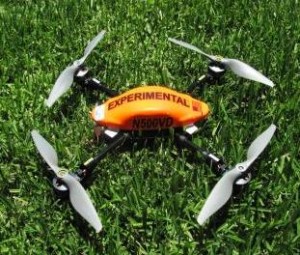
A SDG&E Drone
San Diego Gas and Electric made the power news for setting its sights on using drones to monitor its transmission lines. No longer limited to model airplane enthusiasts and real estate developers, “unmanned aerial systems” appear ideally suited to the rugged terrain that power lines often encounter. The drones will be used to cruise the lines checking for hot spots on the system.
Drones also may be poised to revolutionize agriculture, flying low over crops to determine their vitality, moisture levels, maturity, etc. Experts envision drones being used as precision crop dusters, much like drip irrigation systems. They can stream photos and videos, or they can be modified to land and take water and soil samples. And they may be best for high-value crops, like wine. Drones can help with decision-making as to which vineyards to harvest first, and at what time, and which vines need more or less nutrients.
Three Feet and Free Bikes
 California has passed legislation called “Three Feet for Safety” that keeps cars at least three feet away from bicyclists while passing. If traffic is too heavy to change lanes, or if conditions make the three-foot barrier impossible, the driver must slow to a reasonable speed and wait to pass until it is safe to do so. The law is part of the transition in which cars share the road with bicycles, especially in dense urban areas. In Los Angeles, an MTA campaign notes that “Every lane is a bike lane…” And the three foot rule does not mean that an automobile cannot get within three feet of a cyclist. The motorist can, and can pass, but only at a “safe and reasonable speed.” While it may not be enforceable, the law raises awareness and promotes safety. California is the 24th state to pass the bicycle buffer zone legislation.
California has passed legislation called “Three Feet for Safety” that keeps cars at least three feet away from bicyclists while passing. If traffic is too heavy to change lanes, or if conditions make the three-foot barrier impossible, the driver must slow to a reasonable speed and wait to pass until it is safe to do so. The law is part of the transition in which cars share the road with bicycles, especially in dense urban areas. In Los Angeles, an MTA campaign notes that “Every lane is a bike lane…” And the three foot rule does not mean that an automobile cannot get within three feet of a cyclist. The motorist can, and can pass, but only at a “safe and reasonable speed.” While it may not be enforceable, the law raises awareness and promotes safety. California is the 24th state to pass the bicycle buffer zone legislation.
Free Bikes: What an idea, a pioneering business model from a couple of USC grad students from Denmark: Free bikes clad with advertising. Initially, the grad students just wanted to make bikes more accessible to their friends on the USC campus. Now thanks to their vision, students at colleges coast to coast – USC, UCLA, Stanford, MIT, University of Arizona, and about 18 others – can plunk down a $149 deposit and get a free bike – complete with lock and maintenance – for the academic year. Branding indeed, FreeBike brings low-cost beach cruisers and basic mobility to students. And FreeBikers are required to post at least one photo of their bike to social media each month, travelling ads, gifts and rewards for FreeBikers that take other actions.
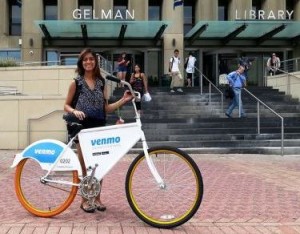 At any given time, using the space between the handle bars and bike seat and main sprocket for a placard advertisement, the FreeBike Project runs messaging from the American Heart Association, the ride-share program Lyft, North Face, and music events produce by AEG Live. Currently the fleet tops 800 bikes. Founders Bender and Sanderhoff intend to have 10,000 mobile billboards in service by 2016. And the founders have pledged that for every bike they lease in America, they will donate a bike to a child in the developing world. The FreeBike Project has a strong philanthropic component, helping students living in poverty.
At any given time, using the space between the handle bars and bike seat and main sprocket for a placard advertisement, the FreeBike Project runs messaging from the American Heart Association, the ride-share program Lyft, North Face, and music events produce by AEG Live. Currently the fleet tops 800 bikes. Founders Bender and Sanderhoff intend to have 10,000 mobile billboards in service by 2016. And the founders have pledged that for every bike they lease in America, they will donate a bike to a child in the developing world. The FreeBike Project has a strong philanthropic component, helping students living in poverty.
EcoMotion Highlights
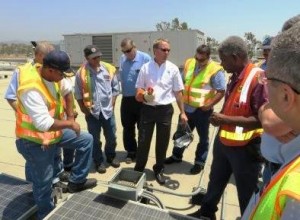
EcoMotion’s Troy Strand trains Metro staff
PV Training, Los Angeles: EcoMotion recently trained 40 Los Angeles Metro engineers and facilities maintenance professionals on solar maintenance. The two-day, 164 slide course featured four classroom modules on PV Theory, Metro’s Installations, Solar Safety, and Preventative Maintenance. In addition the course involved rooftop hands-on analysis and measurement to assure fully functional solar systems at maintenance divisions. EcoMotion’s Senior Solar Specialist Troy Strand provided the training at three Metro maintenance facilities that already have solar, including the Regional Rebuild Center, a massive bus maintenance facility topped with a 1 MW array. As part of a multi-task solar consulting role, EcoMotion has also prepared solar specifications for Metro roof and ground-mounted solar systems.
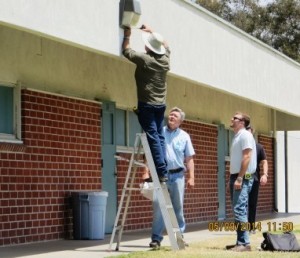 Climate Smart Schools, California: EcoMotion’s west coast campus project – Climate Smart Schools – is in full swing, with energy management plans being developed for two major school districts in Southern California. In each case, the CSS team is analyzing energy use, benchmarking more than 100 campuses, developing matrices of retrofit opportunities, and determining efficiency upgrades and renewable installations that make sense. In Poway, efficiency retrofits are focused on four high-use schools. In Garden Grove, 14 schools will get exterior LED lighting retrofits through the project, boosting safety and security on campuses. In related news, Ted Flanigan is speaking about the strategic use of Solar PPAs in Prop 39 funding at three School Energy Coalition forums this fall in Sacramento, Riverside, and Santa Ana.
Climate Smart Schools, California: EcoMotion’s west coast campus project – Climate Smart Schools – is in full swing, with energy management plans being developed for two major school districts in Southern California. In each case, the CSS team is analyzing energy use, benchmarking more than 100 campuses, developing matrices of retrofit opportunities, and determining efficiency upgrades and renewable installations that make sense. In Poway, efficiency retrofits are focused on four high-use schools. In Garden Grove, 14 schools will get exterior LED lighting retrofits through the project, boosting safety and security on campuses. In related news, Ted Flanigan is speaking about the strategic use of Solar PPAs in Prop 39 funding at three School Energy Coalition forums this fall in Sacramento, Riverside, and Santa Ana.
 Bryant University, Rhode Island: EcoMotion has completed the first revision of Bryant University’s Sustainability Plan. The 2.0 Plan serves as a campus roadmap for fostering environmentally sound, socially equitable, and financially responsible practices as Bryant. It includes two new domains, supply chain management and food and dining. The Plan provides background and baseline information, lists strategies, and presents goals with correlating baseline metrics for each domain. The Plan also contains new Energy Guidelines for Campus Sustainability including expectations for community members and departments. Its appendix it’s an implementation tracking system which measures progress and savings for each goal.
Bryant University, Rhode Island: EcoMotion has completed the first revision of Bryant University’s Sustainability Plan. The 2.0 Plan serves as a campus roadmap for fostering environmentally sound, socially equitable, and financially responsible practices as Bryant. It includes two new domains, supply chain management and food and dining. The Plan provides background and baseline information, lists strategies, and presents goals with correlating baseline metrics for each domain. The Plan also contains new Energy Guidelines for Campus Sustainability including expectations for community members and departments. Its appendix it’s an implementation tracking system which measures progress and savings for each goal.
It’s a new year and EcoMotion is managing a new cadre of passionate Student Sustainability Ambassadors at Bryant. This student engagement program facilitates the growth and experience of student leaders, develops peer-to-peer networks for inspiring positive behavior change and awareness, and assists in coordinating campus wide sustainability initiatives and campaigns. EcoMotion is excited to see the growth and results of the comprehensive sustainability program at Bryant this academic year, with an ever-more-integrated role with the campus facilities team.
 Green Revolving Funds, New England: Campus Services wrapped up coordinating the Leaders in Energy Efficiency Financing Network for the Sustainable Endowments Institute, reaching out to over 125 schools across Massachusetts, Maine, New Hampshire, Connecticut, and Rhode Island. By the end of the program 21 schools plus the city of Cambridge and the City of Boston were exploring a green revolving fund as a financing mechanisms for energy efficiency. Revolving funds are proven means of recycling dollars, leveraging investments in efficiency and renewables by taking a share of the savings to invest in more projects and thus more savings. While the largest funds are at University of Vermont and Harvard, SEI is keen on the involvement of many schools that want to start small, recognizing the value of institutionalizing the revolving fund approach and scaling over time.
Green Revolving Funds, New England: Campus Services wrapped up coordinating the Leaders in Energy Efficiency Financing Network for the Sustainable Endowments Institute, reaching out to over 125 schools across Massachusetts, Maine, New Hampshire, Connecticut, and Rhode Island. By the end of the program 21 schools plus the city of Cambridge and the City of Boston were exploring a green revolving fund as a financing mechanisms for energy efficiency. Revolving funds are proven means of recycling dollars, leveraging investments in efficiency and renewables by taking a share of the savings to invest in more projects and thus more savings. While the largest funds are at University of Vermont and Harvard, SEI is keen on the involvement of many schools that want to start small, recognizing the value of institutionalizing the revolving fund approach and scaling over time.
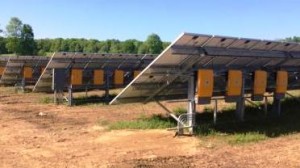
Millbrook’s solar array
Millbrook School Solar, New York: EcoMotion has served as the owner’s rep for a 1.73 MW solar system at Millbrook, a small boarding school located about two hours north of New York City. Constituting Phase One of the school’s carbon neutrality plan, the solar system will provide 100% of the entire campus’s electricity. The project covers 7.5 acres, one of several “south fields” on the school’s idyllic 800-acre campus. Financed with a Power Purchase Agreement (PPA) through SolarCity, Millbrook will save ~$30,000 in the first year, and then over a million dollars in 20 years thanks to a 7.5 cent/kWh PPA price with a 0% escalator. Savings will be reinvested in efficiency measures identified in all 43 school buildings. Later carbon neutrality phases include additional geothermal and potentially a community biofuels plant using neighboring farm’s wastes.
